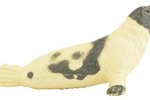
One of the most highly recognized marine mammals is the bottlenose dolphin, the charismatic star who makes a big splash at aquarium shows around the world. Outside of captivity, these dolphins swim in waters whose surface temperatures range from 50 to 90 F. While you may find 50 degrees too chilly, yet revel in diving into 80-degree ocean waves, dolphins possess several thermoregulatory features that enable them to adapt to the sizable temperature range.
Cosmopolitan Cruiser
Dolphins do not occupy polar regions. Preferring warmer climates, they thrive within the geographical range of 45 degrees north and south of the equatorial line. Dolphins are predominantly found in tropical and temperate bodies of water that include the Atlantic, Pacific and Indian oceans as well as the Mediterranean, Black and Red seas. They range from as far north as Nova Scotia, Norway and northern Japan to as far south as Chile, the southern tip of Africa and Australia. Dolphins have been classified into two ecotypes to include those who reside in coastal waters and those who swim deeper into offshore ocean sites. Offshore dolphins are biologically adapted for life in cooler temperatures.
Less Surface, More Blubber
Like other mammals, dolphins are warm-blooded creatures with endothermic regulation, meaning that dolphins are able to maintain steady core body temperatures of 96.8 to 98.6 F. Dolphins generate body heat through a higher metabolic rate that exceeds that of most land mammals. Also unlike land mammals, dolphins require fewer breaths for respiration, minimizing heat loss on exhalation. Additional features that enable a dolphin to maintain this temperature in cooler waters lie within his body’s physique. His large body is tapered at both ends, and his flippers and dorsal fin are small in size. This means that his body heat does not need to be widely dispersed and stays compacted. A barrier of blubber, a thick layer of connective tissue and fat cells, insulates the body to retain the heat within.
Heat Conservation Through Circulation
A dolphin’s circulatory system is adapted for distributing and conserving body heat while circulating blood. Arteries and veins within the flippers and dorsal fin are closely intertwined. This network allows for the blood in the arteries, which is warmed from the body’s core, to warm the blood within the neighboring veins that has cooled on its circulatory journey into the flippers and back toward the heart within the body’s core. This circulatory system adjusts according to temperature needs. When the dolphin swims in cold water, blood circulation decreases to flipper vessels and increases to those within the main body. To prevent the dolphin from overheating in warmer water or during periods of increased physical activity, circulation adapts by decreasing blood flow to the body and increasing flow to the flippers.
Change of Scenery
Some dolphins migrate from one area to another as water temperatures change. Some coastal dolphins who reside in the northern reaches of their range travel further south during the colder months, such as those who seasonally migrate along the Atlantic coast of the United States. Migrations of the fish on which they feed also prompt cyclical changes of residence for some dolphins. Wherever the dolphin decides to take a swim and make a splash, his unique adaptations ensure that his body temperature remains comfortable throughout his life’s aquatic adventures.
References
Photo Credits
-
Tom Brakefield/Stockbyte/Getty Images




